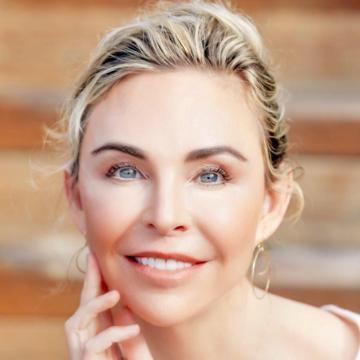
Teaching Kids to Embrace Self-Compassion
Shauna Shapiro
Self-compassion is a super power. And yet, learning to be kind to ourselves takes practice, says Professor Shauna Shapiro. It’s so much easier to get stuck in ways of thinking that don’t serve us, such as shame, self-criticism, and negative self-talk.
This negative self-talk is not only harmful for our mental health, shame actually shuts down the learning centers of the brain, keeping us stuck in unhealthy behaviors, robbing us of the resources to change.
Teaching children how to let go of self-judgment and treat themselves with kindness is an essential skill, says Shapiro. And it can be taught.
Taking a cue from “Good Morning, I Love You,” her 2020 book on mindfulness and self-compassion for adults, Shapiro has written a new book with a similar message for children, “Good Morning, I Love You, Violet!”
The 32-page brightly illustrated story—aimed at youngsters ages 3 to 8 years old—features a skeptical young girl named Violet who struggles with not feeling good enough or smart enough. But at school, she learns to counter her negative self-talk by learning a new practice to cultivate self-compassion. Each morning, she places her hand on her heart and says, “Good Morning, I Love You, Violet!”
We sat down with the clinical psychologist to talk about the book, available on Oct. 24, and how she hopes it can give children new tools and skills to help them develop self-compassion.
What spurred you to write this children’s book?
As I delved into the field of neuroscience and learned about the extraordinary plasticity of a child’s brain, it seemed crucial to explore ways to help hardwire resources at an early age. Children’s brains are able to absorb information so much faster than adults, and what they learn is much more durable. For example, as a child when we learn a language or how to ride a bike, we don’t forget. And so it kind of hit me over the head: childhood is the ideal time to teach social and emotional tools that can resource our children for their entire lives. With the help of a wonderful co-writer, Jennifer Adams, and illustrator Susan Schaefer, I hope what we produced will provide a simple, joyful entry point for young kids, and for their parents, too.
In the story, Violet learns about “planting seeds of kindness” along the way. What does that mean?
Planting seeds of kindness is a metaphor for neuroplasticity. One of my favorite phrases is, “What you practice grows stronger.” This is the core of neuroplasticity—our repeated behaviors, thoughts and emotions can shape our brains.
If we plant seeds of kindness, we will grow kindness.
We can also plant seeds of fear, and they will grow. We have a choice about where we focus our attention and what seeds we plant.
By planting seeds of kindness in ourselves, they ripple out into the world. We are never just practicing for ourselves. Everything we do impacts each other.
Where did Violet learn to feel a sense of shame, or that she’s not good enough?
Unfortunately, the message we get from our culture is that we need to beat ourselves up or push harder in order to succeed. Our children see this and it becomes ingrained. They see it in their parents. As parents, we often tell our kids one thing, but the way we act toward ourselves is very different. If we tell our kids to practice self-compassion, but then treat ourselves with harsh self-judgment, they see this. Our children need to see a compassionate mindset, not shame.
The idea of treating ourselves with kindness is actually quite radical. Learning to interrupt our negative self-talk and be on our own team is not common—that is why it often feels so foreign. And yet, the science behind it is compelling. Self-compassion leads to lower stress, depression, anxiety and increased resilience and happiness. My hope is that this book helps bring the idea of self-compassion to both parents and children, so they can plant these seeds of kindness together.
Illustrated cover of the new children's book, "Good Morning, I Love You, Violet!"
What is the significance of placing a hand over your heart?
When you place your hand on your heart it is a gesture of self-care. In fact, it releases oxytocin, the love and safety hormone. It is a wonderful way to soothe and comfort ourselves. This is an important part of the practice because it can be awkward and vulnerable to offer yourself love. We are not taught or encouraged to love ourselves. In the story, Violet is skeptical, muttering, “How is self-love going to help?” Violet has to work through these doubts, to learn to be kind to herself. It takes courage and vulnerability to practice self-love. By placing a hand on her heart, it helped to create a safe environment to practice kindness.
Another reason it is helpful to place a hand on your heart when you are saying “Good Morning, I love you” is because it helps this become an embodied learning, instead of just a mental activity. For Violet, we emphasized the physical sensation of kindness—the feeling of warmth in her heart. We helped her come alive by having her heart glow with love at the end.
What prompted your interest in the subject of shame?
Working as a clinical psychologist with people from all walks of life—women with breast cancer, veterans, parents, stressed-out college students, high-level executives—what surprised me most was that everyone was talking about the same thing: this tremendous self-judgment. So, I became curious: Is shame helpful? Does it motivate you to eat healthier? Does it help you succeed at work or help you become a better parent? That’s when I learned the incredible research that shows that shame doesn’t work—it can’t work. Shame literally shuts down the learning centers of the brain and robs us of the resources we need to change.
So what’s the alternative?
All of us make mistakes. We all have things we want to change. Self-compassion is the surprising alternative. When we are kind to ourselves it releases oxytocin, serotonin, and dopamine, and this chemical milieu sets us up to win; it sets us up to learn, heal, repair and move forward.
You mention there is healthy remorse and toxic shame. What’s the difference?
Healthy remorse evolutionarily is really important. When we make a mistake, it’s adaptive that we feel remorse. This pain is what motivates us to learn and repair. But often healthy remorse can go awry. Instead of picking ourselves up and learning, we start beating ourselves up. Instead of self-compassion, we kick ourselves when we are already down. This is toxic shame. This relentless negative self-talk—we’d never speak to someone else the way we do to ourselves.
Self-compassion, on the other hand, soothes us when we are in pain and allows us to see our mistakes and learn from them. Self-compassion gives us the courage to face our struggles and to grow into our best selves.
As a mother, when asked what I believe is the most important thing we can teach our children, I always answer “self-love.” Learning to be on our own team, to treat ourselves with kindness, is life-changing. There is no greater gift we can give our children. There is no greater gift we can give ourselves.
I hope this book will plant seeds of kindness that ripple out into the world.

